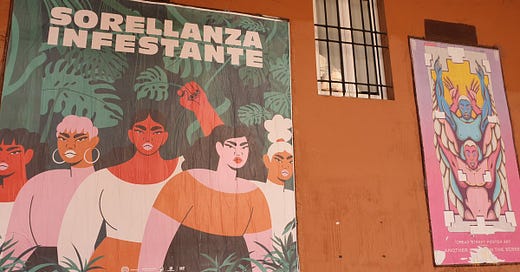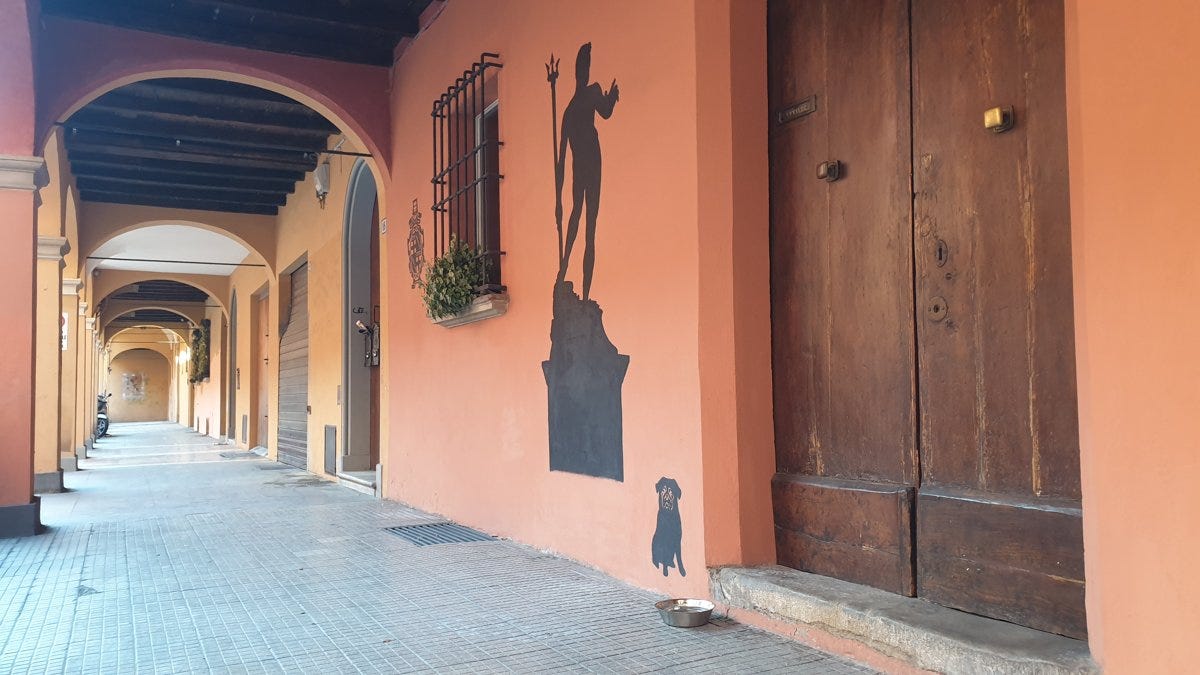Boredom & The World Heritage Site
Lorenzo looks me in the eye, finger tips pressed together, and delivers his final verdict: 'Seriously, there’s no point. Why would you even do that? Why?'
Happy Friday!
Lorenzo looks me in the eye, finger tips pressed together, and delivers his final verdict:
Seriously, there’s no point. Why would you even do that? Why?
Greetings from the portico-shaded streets of Bologna, where I’ve spent the past week relaxing — and, in peak moments, getting really, really bored.
Hence my appearance in the tourist office of Piazza Maggiore and the kindly intervention of Lorenzo’s baffled condemnation.
Welcome to edition 332.
👋 My name is David and I’m a writer, outdoor instructor and cyclist-at-large with Thighs of Steel. I write stories that help you and me understand the world (and ourselves) a little better.
This is a story about boredom and Bologna’s World Heritage Site.
Boredom & The World Heritage Site
We can think of all human emotion as lying somewhere along two axes of ‘activated’ and ‘deactivated’ brain states.
At polar ends of the activated axis we have sensations of elation (positive) and distress (negative), while at either end of the deactivated axis we have relaxation (positive) and boredom (negative).
What’s interesting is that we are at our most creative when we are either elated or bored. Relaxation, it turns out, is a bit meh — uninspiring.
According to this 2014 study by Karen Gasper and Brianna L. Middlewood, this boost in creativity comes because both elation and boredom make us seek out novel experiences.
When we’re elated, we’re well up for anything. And when we’re bored we’ll do pretty much anything to shake ourselves out of the torpor — even crappy things (as found by researchers Bench and Lench) like voluntarily giving ourselves random electric shocks.
After the non-stop hectic mess of the past month, cycling from Glasgow to Milan with Thighs of Steel, I was in desperate need of some restorative boredom.
A week in Bologna yawned ahead of me.
On Monday, uncertain of the precise voltage of the Italian electricity supply, I spent a listless half hour on Boring Games.
A ‘game’ called leftRight was particularly unstimulating, clicking the buttons ‘Left’ or ‘Right’ in order to print ‘L’ and ‘R’ character artwork:
When that got too exciting, I watched someone play a video game in which nothing happens. For eight hours.
That dealt with day one of my holiday. But how, I wondered, staring at the featureless expanse of ceiling above my bed, would I mine enough ennui to last the week?
The demise of the telephone book and the rise of the Internet has really foreshortened the tiresome traveller’s repertoire of pointless activities.
That’s when I discovered that the old town of Bologna has 38km of porticos, colonnaded, arcaded streets, crying out to be walked in their labyrinthine entirety.
Fearful that such a ridiculous idea might already be a firm fixture on the tourist trail, especially since the porticos were inscribed as a UNESCO World Heritage Site last year, I went to see Lorenzo at Bologna Welcome.
I needn’t have worried.
Walking The Portici
Not only have the porticos of Bologna not been mapped, not only have they not been walked, but such a tour would be a blasphemous insult to the fundamental reason for their existence.
Lorenzo was quite clear:
Let me give you an example. There is a park, the Park of Montagnola. You go there — and I’m not saying you should go there, but if you are passing — there is a very cool statue.
There are four ways to the statue, but there are also dealers in the park, you know? You walk up one way, you are at the statue. So why walk the other ways, with the dealers? There is no reason to do that.
I nod enthusiastically. ‘Exactly!’
Lorenzo tosses his head: ‘It’s like wanting to walk all the freeways in your city — after a while they are all the same!’
I nod enthusiastically. ‘Exactly!’
I’m thinking of the absurd futility of the every-single-streeters, walkers and runners who use A to Zs or CityStrides to mark off, well, every single street in their city. Or, in the case of a Canadian I met with this mission, pass The Knowledge.
Lorenzo is thinking of my mental health.
The porticos are where we go to meet friends, where we chat, have a drink, eat. They are nothing by themselves. Seriously: just go out and meet people — that’s the only way to understand the porticos.
Despite his misgivings over my desecration of his city, with the heavy heart of a noble man paid to enable idiotic tourists, Lorenzo hands over a map of the old town.
All the streets are here, all the porticos. You will see. There is no reason to do that. You will get tired of all the same view, the same view. But seriously: keep me posted.
I switch on my GPS tracker and begin.
Following my paper map, crossing off streets without porticos, tracing back and forth the ones that do, pursuing dead ends, blind alleys, crescents and courtyards, I fall into the monotony, the horror and freedom of this empty reverie.
15km of walking and over 60 photographs later, I haven’t covered a quarter of the city.
I find myself agreeing and disagreeing with Lorenzo. Each stretch of portico is the same and different.
Superficial architectural differences, of course: wood, terracotta brick, marble pavements, vaulted, domed, concrete slab ceilings, columns Doric, Corinthian, Bolognese.
But despite Lorenzo’s concern, the portici are a way into the life of the city. A postive constraint of a dérive, leading me through the streets, almost but not quite at random, nudging me into the creative act of noticing.
A missing cat poster. A beaked day-glo naked skulled statue on wheels ratchet strapped to a pole. A plaque dedication to a partizan killed in the second world war. Graffiti telling me that my flies are down. Anarchist, No Borders slogans: ASSALTA IL CIELO. Gumball machines, condom machines.
I never know whether the next door will open to a tabacchi run by Bangladeshi handing out cups of lemonade or a thirteenth century church of Saint Bartholomew and Gaetano.
Set into niches in the walls are shrines to Madonna and vending machines selling legal cannabis. Sometimes side by side.
At one point, outside the Oratorio dei Bastardini, where the offspring of students and whores were raised, a warm wind snatched my map from my hands and the updraft lifted it high into the vaults where it danced for a full minute as first I flailed and then I laughed on the flagstones below.
With even the portico itself mocking my dependence on direction, I turned my attention to the life-under-arches that Lorenzo spoke about.
Men lying in the shade, some with a cap of coins in front of them. One leaps up and shouts my name when he sees me.
A man ahead whose terracotta trousers matches the terracotta paint on the walls. Lovers twisted around one another. A student leaning against a column waiting for her email to open.
Smokers smoke greeting each other across the columns’ shadows cast. A courtyard glimpse of family life. Osteria and trattoria preparing for the evening, metal chairs clattering on cobbles.
As my spiral turns back towards the Piazza Maggiore, the tourists converge with a strangely listless jibberjabber: ‘I appreciate architecture so much more now,’ one young American says to another, without answer.
She sounds bored, but yet not in the creative blank space that I have been seeking. I wonder if there’s a sweet spot of boredom that the numbered tourists sights overstimulate.
Passively reading the phone book leads to a more creative state than copying out the phone book, so perhaps shines, frescos and statues take tourists one notch higher on the boredom scale: not high enough for elation, but not low enough to allow for creative daydreaming.
I walk back up the steps to the tourist office: it’s two minutes to closing and Lorenzo is cashing up the till.
He smiles and almost shakes his head.
Now Lorenzo’s Way
After my long day’s walk under whitewashed ceilings, I feel almost as indignant as a Bolognese local when I read that the porticos garner a paltry 2.83 stars on World Heritage Site. Beloved Rome, Venice and Florence all score over 4.58.
The written reviews of Bologna bemoan the imprecise, unexceptional, ineffable heritage value of a simple covered walkway.
Even as I agree that there is not much to see, in the traditional sight-seeing sense, I feel that these travellers have somehow missed the sensation of soft wonder that plays between the columns for anyone willing to suspend their qualifying instruments.
Only Maurice, from Switzerland, seems to have captured, in ALL CAPS, what Lorenzo impresses upon me again at the end of my walk:
In fact like the modern videogames Porticoes are INTERACTIVE but they are all TRUES...Here people get the joy to live and to do something together and Porticoes, are the glue that make it possible...
So the next day, I go out and try the porticos Lorenzo’s way.
Instead of walking, I meet people.
Sitting on the polished kerb of the portico outside the Cremeria Santo Stefano, sharing gelato of fig, marscapone and chocolate with new friends, I concede the point to Lorenzo.
If life here is a poem, then porticos are the metre: Bologna is what happens beneath the arches.
100 Days of Adventure 2022
🟢🟢🟢🟢🟢🟢🟢🟢🟢🟢🟢🟢🟢🟢🟢🟢🟢🟢🟢🟢🟢🟢🟢🟢🟢🟢🟢🟢🟢🟢🟢🟢🟢🟢🟢🟢🟢🟢🟢🟢🟢🟢🟢🟢🟢🟢🟢🟢🟢🟢🟢🟢🟢🟢🟢🟢🟢🟢🟢🟢🟢🟢🟢🟢🟢🟢🟢🟢🟢🟢🟢🟢🟢🟢🟢🟢🟢🟢🟢🟢🟢🟢🟢🟢🟢🟢🟢🟢🟢🟢⚪⚪⚪⚪⚪⚪⚪⚪⚪⚪
Free But Not Cheap
That’s it for this week — thank you for reading all the way through.
Any comments, questions, insults to hurl my way? You can reply to this email like any other. My favourite correspondent last week described me as a ‘perverse horn-blowing imp of the ridiculous’.
This newsletter is supported, Patreon-style, by people who click the soothing purple-ish-blue buttons below. £30 per year gives me the means and motivation to keep on writing this little thing. Thank you 🙏
Three Small Things At The End
[LOVE STUFF] The Most Haunting Truth of Parenthood by Mary Laura Philpott is not really about parenthood. It’s about humanhood and how love is much like ‘wearing an invisible explosive vest’:
The longer I live, the more I love, the larger this combustible bundle grows … We cannot really save anyone. Not permanently. The safeguards we set up all fall away. … I cannot shield my beloveds forever, but I can make them lunch today.
[WIND WORD] Psithurism: the whispering sound of the wind among leaves.
[CITIZENSHIT] A friend recently passed the UK’s citizenship test (nice one Ils!), enjoying inane questions like What is the money limit for the small claims procedure in England and Wales?, What is the Church of England known as in Scotland and the US? and When did people learn how to make bronze? Would you pass?
Big love,dc: Your Perverse Horn-Blowing Imp of the Ridiculous






